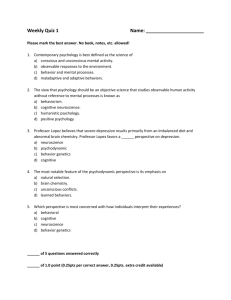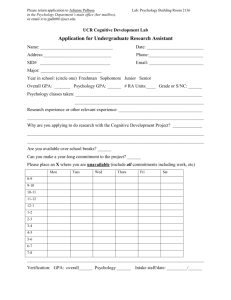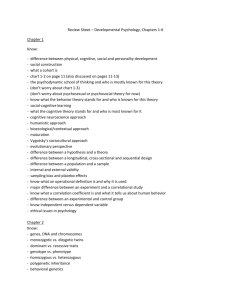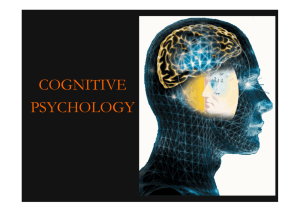Introduction to Cognitive Psychology 1 INTRODUCTION TO
advertisement
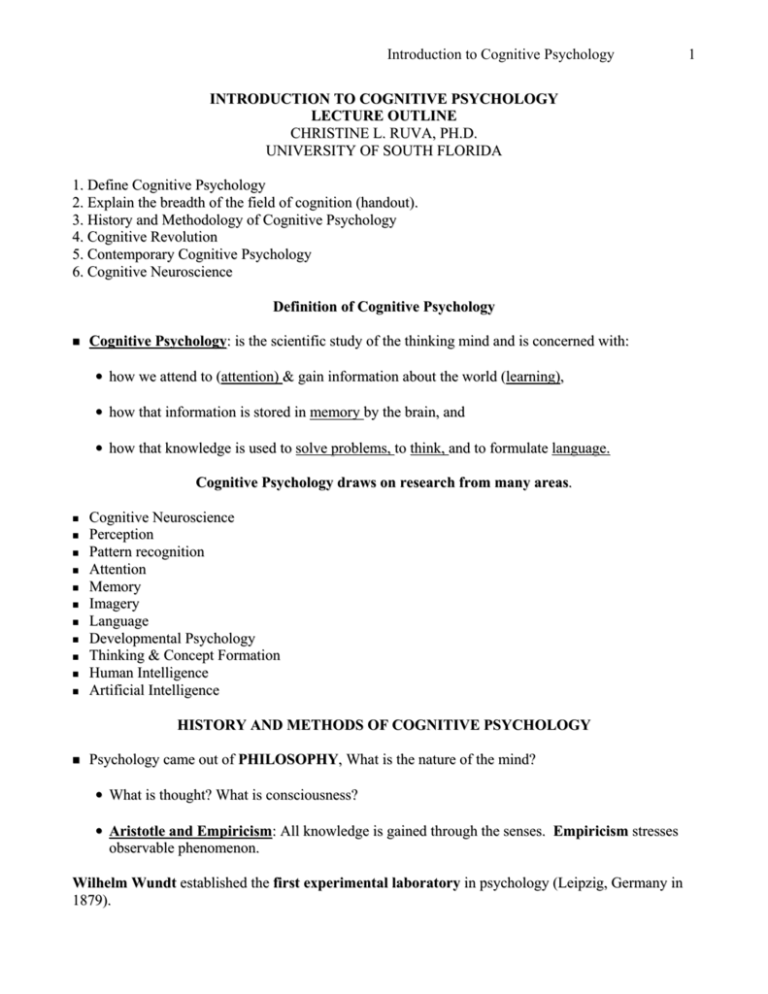
Introduction to Cognitive Psychology INTRODUCTION TO COGNITIVE PSYCHOLOGY LECTURE OUTLINE CHRISTINE L. RUVA, PH.D. UNIVERSITY OF SOUTH FLORIDA 1. Define Cognitive Psychology 2. Explain the breadth of the field of cognition (handout). 3. History and Methodology of Cognitive Psychology 4. Cognitive Revolution 5. Contemporary Cognitive Psychology 6. Cognitive Neuroscience Definition of Cognitive Psychology Cognitive Psychology: Psychology: is the scientific study of the thinking mind and is concerned with: • how we attend to (attention) & gain information about the world (learning), learning), • how that information is stored in memory by the brain, and • how that knowledge is used to solve problems, to think, and to formulate language. Cognitive Psychology draws on research from many areas. Cognitive Neuroscience Perception Pattern recognition Attention Memory Imagery Language Developmental Psychology Thinking & Concept Formation Human Intelligence Artificial Intelligence HISTORY AND METHODS OF COGNITIVE PSYCHOLOGY Psychology came out of PHILOSOPHY, What is the nature of the mind? • What is thought? What is consciousness? • Aristotle and Empiricism: Empiricism: All knowledge is gained through the senses. Empiricism stresses observable phenomenon. Wilhelm Wundt established the first experimental laboratory in psychology (Leipzig, Germany in 1879). 1 Introduction to Cognitive Psychology 2 Structuralism: Structuralism: Wundt wanted to establish psychology as a natural science to show that basic mental processes could be observed & recorded. • the study of immediate conscious experience via introspection. introspection. • Problems with Introspection: poor metacognition Ps are quiet when they are mentally active Unable to replicate results across labs. Subjective method of data collection. excludes young children & animals. HERMAN EBBINGHAUS (1885/1913): a German Psychologist who looked at memory in a reproducible and observable manner. He developed a way to study memory: memory: • nonsense syllables (RIQ, VAP, NAR, ZAT) • Forgetting curve: Memory is best shortly after learning, decays steadily from there • Relearning: Relearning: refers to the number of trials to master material a second time. • Savings score: score: Difference between original and subsequent learning. Criticisms of his methods: methods: • devoid of context and meaningful material • he was researcher, theorist, and subject FUNCTIONALISM: FUNCTIONALISM: Developed in the US in the late 1800s. Led by William James (Principles of Psychology, 1890). • James defined 2 types of memory: memory: one short-term and one long-lasting. Defined psychology as the study of the mind as it functions in adapting the organism to its environment. Functionalist were not concerned with the structure of the mind, but with the purpose or function of consciousness • Wundt asked “What is the mind?” and James asked “What is the mind for?” Applied Psychology. Psychology. FREDRICK BARTLETT: Remembering: An Experimental and Social Study (1932) British Psychologist whose research was ignored in the 1930s because of American commitment to behaviorism, but is valued today. Used meaningful materials: lengthy stories. He studied how mental set (what we now call schemas) affect later recall of a story. Introduction to Cognitive Psychology Memory is constructive: • Our memories for the original event (story) involve interpretation and transformation of the original materials to fit our schema based knowledge of the world. (“War of the Ghosts”) GESTALT PSYCHOLOGY Challenged the Structionalist’s notion that conscious experience could be broken down into elements. • “The whole is greater than the sum of its parts.” • Stresses Emergent Qualities: it is not the elements of consciousness that are important but the relationships among those elements. Gestalt Psychology started in Germany in 1912 with the description of visual illusion called apparent motion. motion. Greatest contributions have been in the areas of perception (organization in pattern recognition) & problem solving (insight). BEHAVIORISM John B. Watson (1924) American Psychologist & founder of behaviorism. • The study human behavior should be limited to what you can see: observable, quantifiable data → behavior. • Nothing inside the head: head: thoughts, decisions, emotions, personality. • Learning grew out of the behavioral school. Contribution to Cognitive Psychology: Psychology: • Operational definitions • Experimental Control was emphasized. Behaviorism thrived in USA for several decades. BIRTH OF CONTEMPRORARY COGNITIVE PSYCHOLOGY: Sept. 11, 1956 at a symposium at MIT. Cognitive Revolution: Revolution: For a time psychology lost it’s mind, but it regained it during the cognitive revolution. Ulric Neisser’s book, Cognitive Psychology, 1967. The journal Cognitive Psychology was begun in 1970. 3 Introduction to Cognitive Psychology 4 FACTORS CONTRIBUTING TO THE RISE OF COGNITIVE PSYCHOLOGY: Complex human behavior could not be explained using only concepts from traditional behaviorism. Exclusive focus on observable behavior & responses could tell psychologist nothing about interesting psychological processes such as thoughts, strategies used in problem solving. Advances in linguistics led to further displeasure with behaviorism. Advances in linguistics led to further displeasure with behaviorism. Skinner wrote Verbal Behavior (1957), (1957), tried to apply behavioral principles to the acquisition of language. Noam Chomsky reviewed the book. • Can’t explain the creativity (generative nature) of language or what children accomplish in a very brief period of time. • LAD: inborn mechanism that allows young children to detect the rules of language. MUCH OF COGNITIVE PSYCHOLOGY COMES FROM INFORMATION PROCESSING THEORY This evolved from computer science and communication science. science. 3 important components of information processing approach: approach: • mental processes could be understood by comparing them with the operations of a computer. • a mental process can be interpreted as a flow of info. through a series of stages. • mind as a limited capacity processor: structure and resource limitations Atkinson-Shiffrin Multi-Store Model (1968) • Very influential in persuading psychologists to adopt the Cognitive Approach. • 3 memory stores: stores: Sensory Memory: Memory: • Information stored briefly in same modality as input. • A tiny fraction of information in the sensory register is attended to and passed on to STM. Short-term Or Working Memory: Memory: • Information held for 10 to 20 seconds • 7 ± 2 capacity • Attention paid to info then encoded into LTM. • Long-Term Memory: Memory: • Large capacity, relatively permanent storage Introduction to Cognitive Psychology 5 CURRENT ISSUES IN COGNITIVE PSYCHOLOGY A 1990 survey found that 75% of psychologists in U.S. colleges and universities classified themselves as cognitive psychologists. Ecological Validity: conditions in which the research is conducted are similar to natural settings to which results will be applied. COGNITIVE NEUROSCIENCE Examines how cognitive processes can be explained by the structure and function of the brain. This field really took off in the last 2 decades with advances in brain imaging technology. COGNITIVE NEUROSCIENCE METHODS Brain Lesions: Lesions: destruction of tissue. Animal research: research: lesion specific areas of the brain. Humans: the damage is the result of accidents, illness, strokes, or tumors. During WWII major advances were made due to war-related injuries. Relationship between areas damaged and cognitive deficits. This research has increased our understanding of how the brain is organized. Problems: Problems: (1) damage seldom limited to a specific area and (2) therefore researchers cannot associate a cognitive deficit with a specific brain structure. COGNITIVE NEUROSCIENCE METHODS Brain Imaging (PET, CAT, MRI, fMRI) is the most recent advancement. Brain activity is measured and then the computer uses the measurements to produce a brain image. PET scan, scan, or positron emission tomography: measures the blood flow within regions of the brain in order to obtain a picture of brain activity. • Injection of radio-active glucose into blood vessels which carry the chemical to the brain, and the active regions in the brain temporarily accumulate this chemical. Introduction to Cognitive Psychology 6 COGNITIVE NEUROSCIENCE METHODS MRI, MRI, or Magnetic Resonance Imaging: researchers pass a strong (but harmless) magnetic field through a person’s head that affects the activity of hydrogen atoms in water. fMRI (Functional MRI) it measures the amount of oxygen in the blood in various brain areas. • It can make an image of blood flow changes across a 5-second period, whereas an MRI requires 90 seconds and the PET scan at least 30 seconds. • fMRI produces more highly detailed images than PET scan at much lower cost and is less invasive with no radioactive injection. COGNITIVE NEUROSCIENCE METHODS ERP (Event Related Potential Technique) records the tiny fluctuations (lasting less than 1 second) in the electrical activity of the brain in response to a stimulus. TODAY THE BRAIN ANALOGY SERVES AS A MODEL FOR COGNITIVE PSYCHOLOGY Parallel Distributed Processing Models (McClelland & Rummelhart, 1986): Cognitive Processes can be understood in terms of networks that link together neuron-like units. • Connectionism or Neural Networks. Assumptions of PDP Models: Models: • Many cognitive processes could not be localized in a particular pinpoint-sized in the brain. Instead the neural activity is distributed throughout a section of the brain. • Information from the environment is taken into the system in a parallel fashion.



